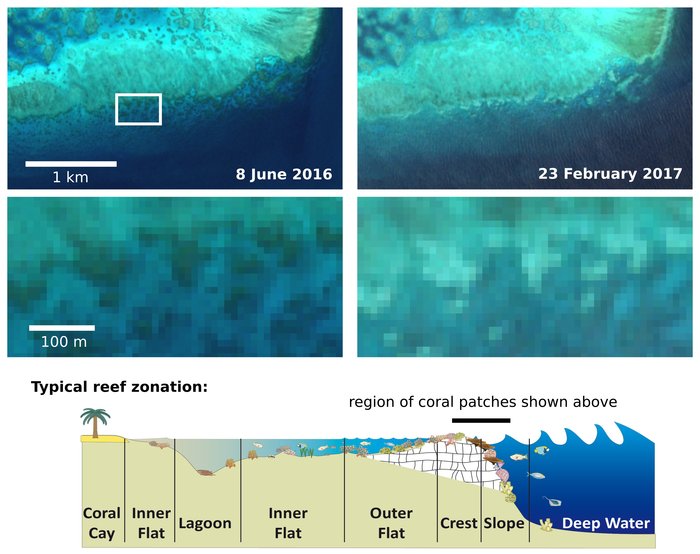Bleaching of Australia’s Great Barrier Reef can now be seen from space
The corals of Australia’s Great Barrier Reef have now suffered two bleaching events in successive years and experts are concerned about the chances for reef survival after observing the phenomenon with the help of satellite images provided by ESA’s Sentinel-2. The bleaching are warming-induced events, affecting the reef ecosystem, and thus fisheries, regional tourism and coastal protection.
Bleaching happens when algae living in the corals’ tissues, which capture the Sun’s energy and are essential to coral survival, are expelled owing to high water temperatures. The bleached state of a coral can last up to six weeks. The corals might recover, or die and become covered by algae, in either case turning dark again, making them hard to distinguish from healthy coral in a satellite image. Such a pattern requires systematic and frequent monitoring to reliably identify a coral bleaching event from space, ESA says.
Studying Sentinel-2 images captured over the reef between January and April, scientists working under ESA’s Sen2Coral project noticed areas that were likely to be coral appearing to turn bright white, then darken as time went on. The event was confirmed by two successive images captured in February, indicating the approximate duration of the bleaching being at least 10 days.

Thousands of geo-located photos of the corals in January and again in April were collected during field campaigns in the area. Scientists used them to confirm the satellite observations.
“Sadly, in the areas where bleaching can be seen, the abundant coral cover we observed in January was in April mostly overgrown with turf algae, with only some individual coral species surviving. The imagery and field data suggest this area has been hit badly,” Dr Chris Roelfsema of the University of Queensland’s Remote Sensing Research Centre, and lead of the Great Barrier Reef Habitat Mapping Project, said.
The Great Barrier Reef is the world’s largest coral reef system composed of over 2,900 individual reefs and 900 islands stretching for over 2,300 kilometres (1,400 mi) over an area of approximately 344,400 square kilometres (133,000 sq mi). The reef is located in the Coral Sea, off the coast of Queensland, Australia. The Great Barrier Reef can be seen from outer space and is the world’s biggest single structure made by living organisms.